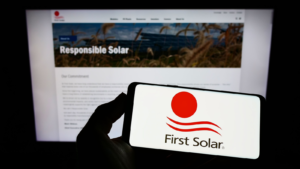Exit Now! 3 Solar Stocks to Sell in February 2024.
There are some solar stocks to sell that I believe will disappoint investors with their results. These companies are standing on shaky ground, with near-term headwinds battering their fundamentals and valuations.
Investors should carefully consider the solar stocks to sell in this article. I believe there are far better opportunities for investors elsewhere. Here, I delve into the characteristics and challenges that may make certain solar stocks less attractive investments, especially in the near to mid-term.
So, here are three solar stocks to sell for February this year.
First Solar (FSLR)

First Solar (NASDAQ:FSLR) is one of those solar stocks to sell. Despite a strong backlog of orders through 2026, the stock faced a notable sell-off in the past six months, with its stock price dipping 13.75%.
The company’s sales expectations for 2023 are between $3.4 and $3.6 billion, with gross profit projected in the range of $1.2 to $1.3 billion. Operating income is anticipated to be between $745 and $870 million, with shipments expected to be between 11.8 to 12.3 gigawatts.
There are some considerable negatives that investors must contend with for FLSR stock. For one, it trades at 35 times earnings and is currently tearing through its balance sheet with high capital expenditures of $1.37 billion over the past 12 months.
The company’s free cash flow margin of -16.77% must improve in order for it to be a viable investment. And there’s no guarantee it will manage to turn its fortunes around. I feel the risks of holding FSLR stock are too high, and investors should reconsider their position in the company.
SolarEdge Technologies (SEDG)

SolarEdge Technologies (NASDAQ:SEDG) designs, develops and sells direct current (DC) optimized inverter systems for solar photovoltaic installations.
I think SEDG will struggle in 2024. That pessimism is set against a backdrop of challenges faced in 2023, including a revenue decline and missed consensus estimates in previous quarters.
The company’s shares recently saw a decline, with a notable drop after providing a gloomy revenue forecast for the third quarter of 2023. That forecast was because of high inventories and slower installation rates in Europe, causing significant concern among investors and impacting the solar industry at large. SEDG’s stock price has declined 47.82% over the past six months.
Other problems hammering the stock include an EPS miss of -174.27%, with analysts expecting a positive EPS of 0.74, but it ended up reporting a negative EPS of -0.55. Furthermore, revenue next year is expected to contract over 30% to $2.14 billion, so I believe shares could slip much further from where they are today. That makes it one of those solar stocks to sell.
Sunnova Energy International (NOVA)

There are some substantial challenges on the horizon for Sunnova Energy International (NYSE:NOVA). Notably, it faces current unprofitability despite strong demand in the home solar market. While the demand for renewable energy solutions, including solar energy, remains robust, Sunnova’s financial performance has been hampered by its debt levels and operational challenges.
The company’s negative operating, profit and free cash flow margins make NOVA a risky choice, in my opinion.
Then, there’s also some uncertainty for NOVA’s future due to its extremely high cash burn rate via capital expenditures and its need for liquidity on the balance sheet. For the past 12 months, the company’s free cash flow was negative at $1.81 billion, while it has only $467 million in cash and cash equivalents.
It also has over $7.18 billion in debt, giving a net cash position of -$54.84 per share.
I don’t see a way forward for the company without digging itself into more and more debt or diluting shareholders via issuing shares. Both solutions seem unsatisfactory. That’s why it’s one of the solar stocks to sell.
On the date of publication, Matthew Farley did not hold (either directly or indirectly) any positions in the securities mentioned in this article. The opinions expressed are those of the writer, subject to the InvestorPlace.com Publishing Guidelines.

